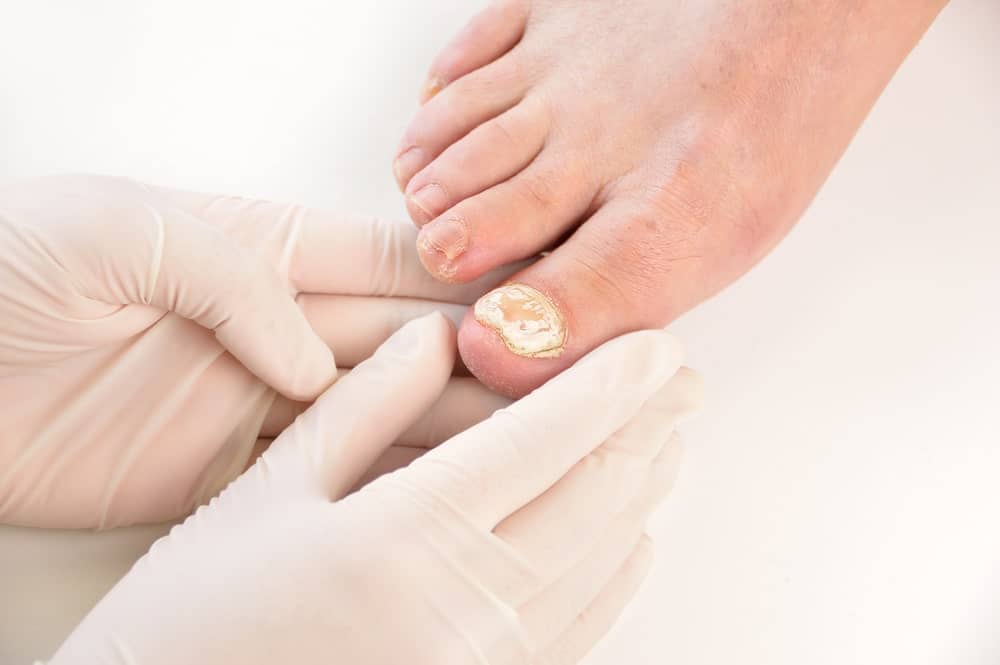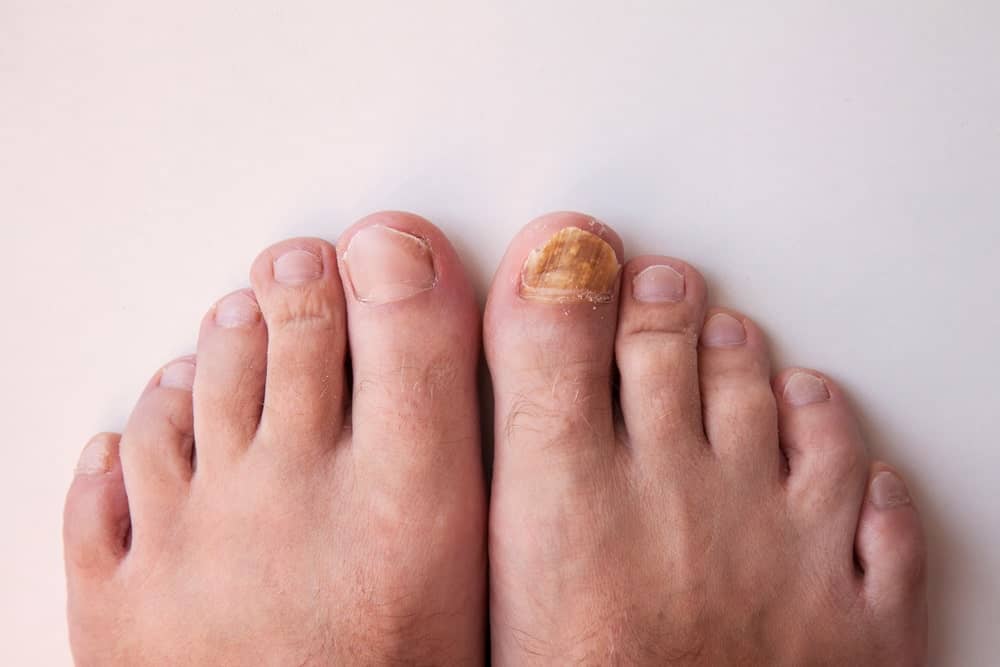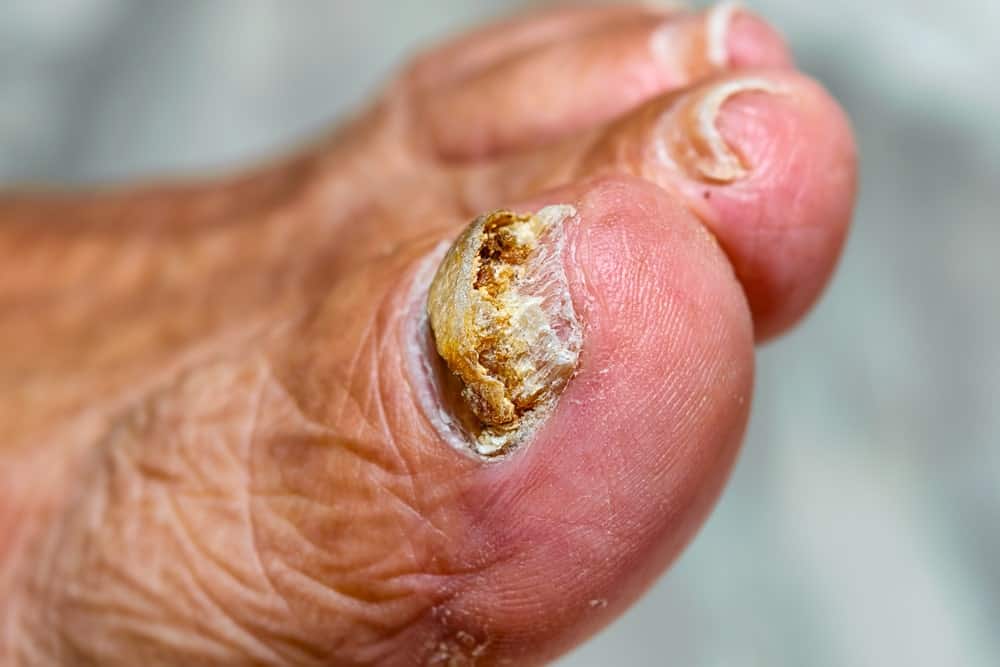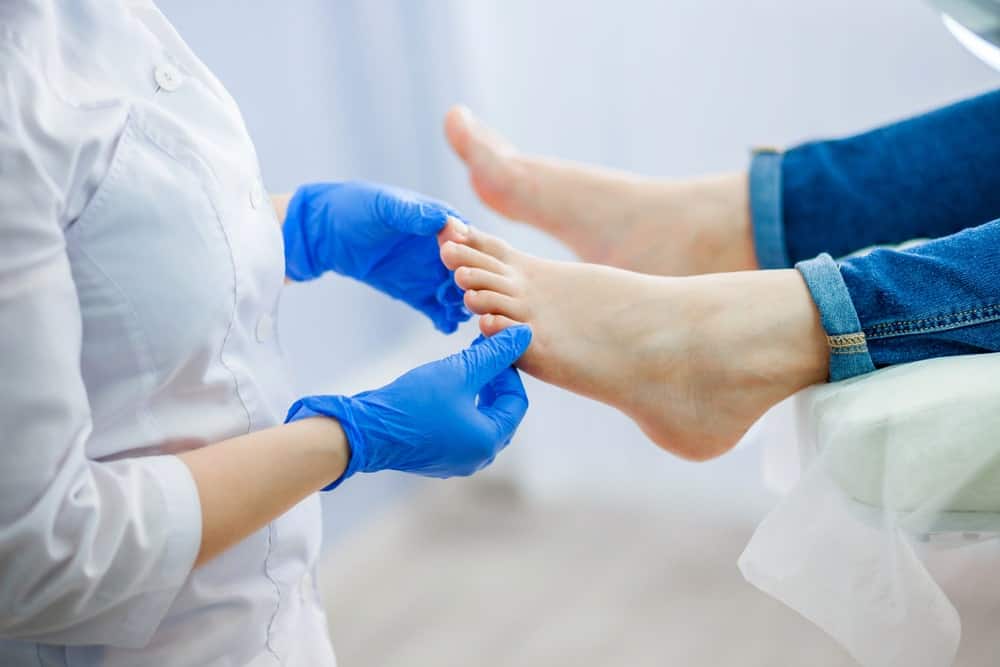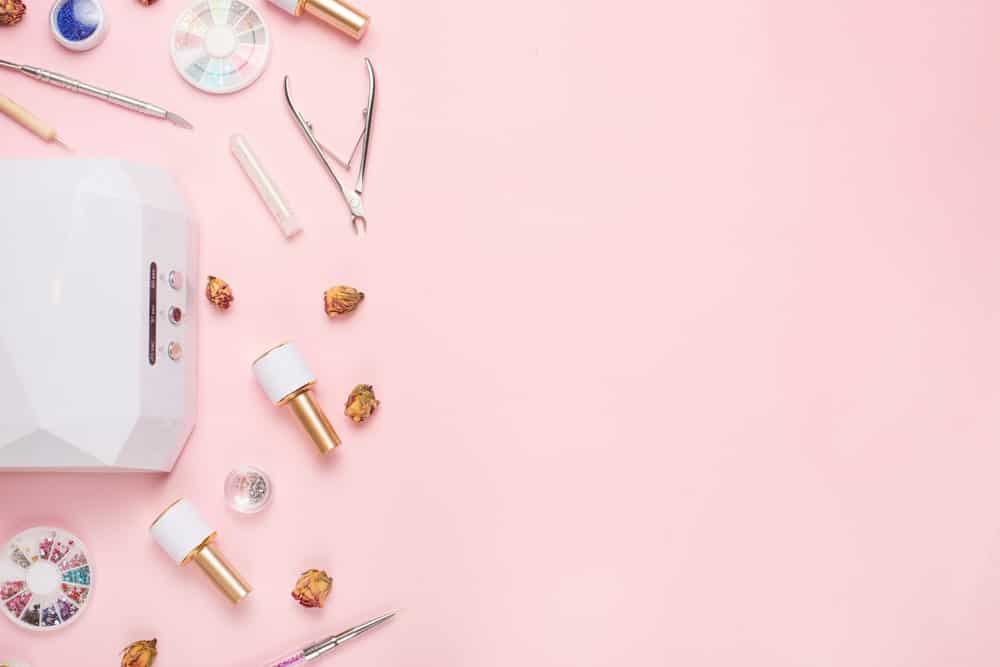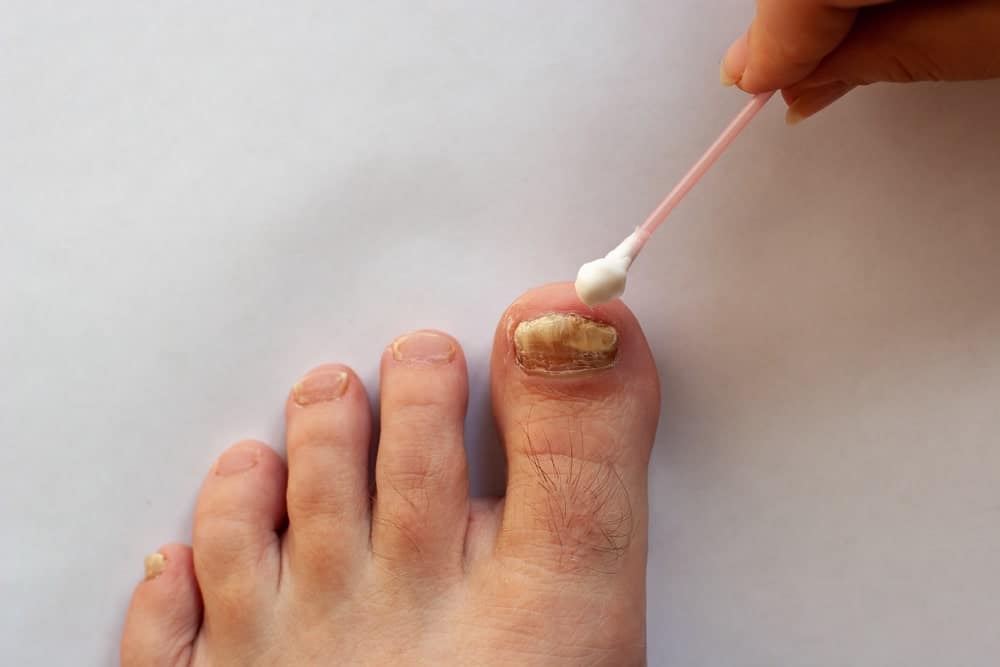You’re ready to give yourself a relaxing pedicure–and then you see your toenail is yellow-tinged, discolored with spots, or peeling. Before you think about buffing or filing off those unsightly marks, it’s more likely than not that you’re dealing with an infection.
Toenail fungus, or onychomycosis, is a common but embarrassing foot infection caused most often by dermatophyte fungi. This type of fungus multiplies in warm, moist environments (think shoes and socks, wet sandals, sweaty feet) and within cracks and cuts. Rough, unhealthy feet are particularly prone to developing toenail fungus, but healthy people of all genders can also suffer from this infection. In fact, professional athletes commonly suffer from fungal foot infections like onychomycosis.
Though notoriously difficult to treat, fungal infections can be eliminated with time and patience. This guide explains how to give yourself a pedicure with toenail fungus as you navigate the healing process.
Signs of Toenail Fungus
If you’re struggling to figure out whether your toenails are discolored from a fungal infection or something else, take a look at pictures of unhealthy toenails to compare bacterial from fungal infections. Classic symptoms of onychomycosis include:
- White or yellow spots on the nail beds that may or may not discolor the entire nail
- Split, cracked, or crumbled nail plates (the upper edge of the nail)
- Thickened toenails, which only happens if the infection is severe
Not all toenail fungus is cause for serious concern. Making simple changes to your routine in conjunction with counter treatment options could eliminate the fungus. However, it’s best to consult your general practitioner or podiatrist for a second opinion to clarify whether you have onychomycosis or another infection.
Toenail Fungus: Causes and Prevention
Toenail fungus isn’t always the result of unclean nail salons. Unless your pedicurist accidentally cut your toe or nail bed, your toenail fungus was likely caused by an underlying health issue, medication, and poor hygiene.
Infected feet
If you’re fighting another fungal infection, toenail fungus is more likely to crop up. The athlete’s foot and ringworm can weaken the constitution of your feet and make your nail beds more susceptible to onychomycosis. Even an injury to your nails from blunt force trauma or too-tight shoes can trigger this fungal infection.
Poor hygiene
Walking barefoot in public locker rooms or showers is also a common culprit of toenail fungus. Always wear a pair of sandals if you need to use the locker room in a gym or public pool. Avoid wearing sweaty socks for long periods of time, especially if your toenails are cracked, as onychomycosis multiples rapidly in damp enclosed spaces. Don’t swap shoes or socks with friends and family members. Keeping your nails short and clean is also important for good foot hygiene.
Old age
Age plays a role in fungal infections, too: older folks are more likely to have brittle nails and dry skin, a hotbed for nail fungus. Roughly one in three people over the age of 50 have had a toenail fungal infection. If you’re older, use a foot scrub or a gentle loofa on cracked feet at least once per week. Apply non-scented lotion to brittle skin once daily to keep your feet supple and healthy.
Sharing nail tools
It’s never a good idea to share toenail clippers, nail files, and cuticle clippers. You may think it’s less risky to have a spa night than visiting a nail salon, but friends and family are just as likely to carry onychomycosis as strangers! All it takes is nicking yourself by mistake with infected toenail clippers to transmit the fungus into your nail bed.
Weakened immune system
Poor immunity allows fungal infections to take root. If you’re chronically ill or recovering from a bacterial or viral infection, you might be more susceptible to developing toenail fungus. Drugs that suppress the immune system, such as corticosteroids to TNF (tumor necrosis factor) inhibitors also promote fungal growth.
If you have asthma, reactive arthritis, repeat tendonitis, an autoimmune condition, IBD, or sarcoidosis, your doctor might prescribe corticosteroids. TNF inhibitors are also prescribed to treat IBD, psoriasis, and rheumatoid arthritis.
Chronic health conditions
Diabetes and thyroid disease are triggers for the toenail fungus. These conditions often cause split nails (onychoschizia ) due to poor circulation (with diabetes in particular) or dry, brittle nails and skin. If you have liver problems, lupus, or another autoimmune condition, you might be unable to take oral antifungal drugs.
Remedies to Treat Toenail Fungus
After you make lifestyle changes to prevent recurring infections, there are many ways you can treat your toenail fungus. Conventional fungal treatments include medicated nail polish, medicated nail cream, and oral antifungal drugs. If your infection is mild, or if you’re anxiously awaiting your doctor appointment, home remedies may provide some relief.
Hydrogen peroxide foot soaks
The acidity of hydrogen peroxide fights toenail fungus. Fill a small bowl or bucket with one cup of peroxide against six to eight cups of filtered warm water. Throw in dried herbs like chamomile and lavender to soothe irritation, and add a few tablespoons of sea salt as a natural antiseptic.
Soak your feet in the water-peroxide mixture for up to 45 minutes. Finish the treatment by rinsing your feet in filtered water, and then thoroughly dry your feet with a clean towel. Repeat the water-peroxide soak twice daily until the infection improves.
Essential oils
Ideal for mild toenail fungus or as an additional form of therapy, essential oils are packed with healing properties.
- Tea Tree Oil contains antibacterial and antifungal properties perfect for fighting toenail fungus. Studies have shown that Melaleuca alternifoliate (tea tree) treats fungal infections like Onychomycosis and Candida. Add 1-3 drops in your daily foot soak.
- Argan oil safely hydrates the skin, healing over painful cracks, and brittleness during the fungal treatment process. If you have an allergy to the fragrance, argan oil will soften your toes and cuticles without irritation. Rub 1-3 drops directly on your toes before bed.
- Thieves Oil is a popular home remedy for toenail fungus that dates back to the Bubonic Plague. To make this healing remedy, mix a carrier oil, such as grape seed oil, with the following elements:
- 1 tbs. Clove Essential Oil
- 1 tbs. Lemon Essential Oil
- 2 ½ tsp. Cinnamon Bark Essential Oil
- 2 tsp. Eucalyptus Essential Oil
- 2 tsp. Rosemary Essential Oil
Topical antifungal drugs
Medicated is often the first line of prescription treatment. If your doctor determines that the infection has not spread to the matrix (core) of your nail, this might be a good option. Topical antifungal drugs also come with fewer side effects than oral treatment options. Expect to be on one of these medications for several months or longer:
- Penlac (ciclopirox) is a medicated nail polish applied to the nail bed. It targets the fungi Trichophyton rubrum but is less effective at destroying other strains; only 12 percent of patients enter remission. As a result, Penlac is usually prescribed with other antifungal treatments.
- Jubila (efinaconazole) is more effective than Penlac, with 55% of patients at the 52-week mark of treatment testing fungus-free.
Oral antifungal drugs
This treatment is ideal for moderate to severe toenail fungal infections that do not respond to topical medication. Oral fungal drugs are highly effective but come with a laundry list of side effects, not limited to diarrhea, headaches, dizziness, ringing in the ears, nausea, and vomiting, and insomnia. Doctors typically prescribe these oral antifungal drugs for diseased toenails:
- Terbinafine treats fingernail and toenail fungus. It can be taken once daily with or without food. Like all antifungals, you must complete the entire course of terbinafine to prevent the fungus from recurring. It is often prescribed for several weeks or longer.
- Â Itraconazole (Sporanox) can be taken once or twice daily with a full meal. If taken twice daily, evenly space out the time between doses. Like Terbinafine, Sporanox is often prescribed long term to achieve results.
- Griseofulvin is less commonly prescribed for toenail infections. This drug treats skin and scalp infections, but it also stops onychomycosis from growing. Expect to take Griseofulvin for at least three months.
Toenail debridement
If your toenail fungus is resistant to topical treatment, your podiatrist may speed up the healing process with toenail debridement. By chipping away at the infected nail bed once per month, your podiatrist will make your toenails more receptive to topical medication. To prevent fungal growth, you will wear a compression bandage called an occlusion dressing while you heal.
Toenail debridement must always be performed by a professional. Resist the urge to poke, pick, and tear away infected parts of your nail bed!
Surgical toenail removal
If you let your toenail fungal infection fester for too long, you may need your doctor to surgically remove the nail and directly treat the skin. This outpatient procedure is performed under local anesthetic and should not take more than 15 minutes. Expect your doctor to numb the area, remove the infected area of your nail or the entire nail, and apply antibiotic ointment to prevent infection during the regrowth process.
Pedicures and Toenail Fungus Tips
If you love getting a pedicure but you have toenail fungus, you won’t be able to visit your salon for several months or more. But you can turn your bathroom into a soothing spa zone without hygiene risks by taking a few simple precautions. If you live with other people, following these tips to contain your fungal infection is especially important.
Nail tools shopping list
The golden rule of giving yourself a pedicure with foot fungus: throw it away when you can. Prioritize cheap but effective nail tools that you can discard after one use. High grade rubbing alcohol is a must for disinfecting your non-disposable tools. Add healing items to your foot soaks and don’t forget to moisturize!
This shopping list is a good place to begin:
- 50 plastic rubber nail cuticle pushers ($9.99, Amazon.com)
- 5 lb. raw dead sea salt ($15.99, Amazon.com)
- Eucerin Advanced Repair Foot Cream – Fragrance-Free, 3 pack ($13.99, Amazon.com)
- Cuticle Trimmer, Professional Surgical Grade ($7.99, Amazon.com)
- Foot Soaking Bath Basin – Large ($14.97, Amazon.com)
- BESTOPE Nail Clippers Set ($8.99, Amazon.com)
- Solimo 99% Isopropyl Alcohol ($6.99, Amazon.com)
How to avoid spreading fungus
- Studies have shown that toenail fungus easily spreads in close quarters. Isolate your infection by using the same foot soak basin for soaks and pedicures, and cleanse the basin thoroughly with Clorox bleach or Lysol. If possible, dump the used water outside.
- Don’t share nail tools with family or friends. Nail clippers and files, cuticle clippers and pushers, and buffers are magnets for fungi.
- Opt for disposal items to remove polish and dry your toes, such as cotton pads. If you use rags or towels, immediately put them in the washer–but first, make sure it’s empty. You don’t want fungal spores from an infected toenail contaminating your (or a housemate’s) undergarments!
- As you give yourself a pedicure, rest your feet on paper towels instead of your bath mat. Wearing disposable flip-flops is the better option if you don’t want to scrub the bathroom floor or tub.
- Leaving your toenails unpainted allows the nail bed to breathe. But if you must embellish your toes (ideally just for special occasions!), plan on throwing the polish away afterward.
10 steps to give yourself a pedicure with toenail fungus
- Fill your sterilized foot bath basin with warm filtered water to ankle height.
- Place a thick layer of paper towels underneath a sterile basin to catch excess contaminated water. Mix a few cups of dead sea salt with several drops of your favorite antifungal, antibacterial essential oils, soak your feet for up to 30 minutes.
- Dry your feet with paper towels, rubbing cotton pads in between your toes. Apply a small amount of non-scented foot cream onto your feet, then your feet on paper towels or put on your disposable flip-flops.
- Lay out your instruments on a paper towel and start by clipping your nails as short as it is comfortable. Do not cut extremely brittle, split nails–allow your podiatrist to take care of infected nail fragments. Place the clippers on a paper towel for used items.
- Using a plastic cuticle pusher, gently push back your cuticles until they separate from the nail bed. Avoid pushing cuticles on deeply infected nails. Immediately dispose of the cuticle pusher.
- Remove exposed cuticle using your cuticle clippers. Afterward, set aside the clippers on the paper towel for used items.
- If you decide to polish your nails, apply only one coat to allow the nail bed to heal.
- Once your polish has dried, sufficiently sterilize your nail clippers and cuticle clippers. Place your tools in a disposable plastic container or a bowl not used for cooking. Fill the bowl with high grade (70% or higher) Isopropyl Alcohol. Let the tools soak for 5 minutes.
- When 5 minutes is up, use dish soap and hot water to cleanse your tools. Store them in a sterile container or in a plastic bag in a dry, clean space.
- Finish with clean up. Throw away your nail polish and disposable tools; use Lysol wipes to wipe down any areas that your feet or your soaking water touched. Dump the bath basin outside, if possible, then fill the basin with warm water and one cup of bleach to sterilize.
Beating toenail fungus is possible if you’re careful about not spreading your infection to anyone else in your home–or back to yourself. Treatment regimens might span the course of several months, but you can still feel beautiful and clean while you heal.
Giving yourself regular foot soaks and pedicures (without polish) will aid the recovery process. Remember: making simple lifestyle changes can help toenail fungus from coming back, but if you self-treat, talk to your doctor to address the root cause. Your funky toenail might be trying to tell you something about your health.

